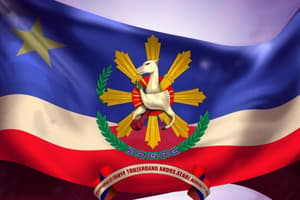Podcast
Questions and Answers
What is the primary purpose of Republic Act 8491?
What is the primary purpose of Republic Act 8491?
- To create rules for national heroes' celebrations.
- To establish national holidays.
- To promote reverence and respect for the national flag. (correct)
- To regulate the use of the national anthem.
When must the national flag be displayed in public buildings according to Republic Act 8491?
When must the national flag be displayed in public buildings according to Republic Act 8491?
- Whenever there are public events.
- Every day throughout the year. (correct)
- From sunrise to sunset only.
- Only on national holidays.
What are the ceremonial actions required during the flag-raising ceremony?
What are the ceremonial actions required during the flag-raising ceremony?
- The anthem should be played in any language.
- Everyone may sit quietly during the ceremony.
- All vehicles must continue moving.
- The assembly must stand at attention when the anthem starts. (correct)
Which of the following locations is specifically mentioned for the permanent hoisting of the flag?
Which of the following locations is specifically mentioned for the permanent hoisting of the flag?
What is required during the flag-lowering ceremony according to the provisions?
What is required during the flag-lowering ceremony according to the provisions?
On which of the following occasions must the national flag be displayed at private residences?
On which of the following occasions must the national flag be displayed at private residences?
Which group is responsible for issuing rules and regulations for proper flag conduct?
Which group is responsible for issuing rules and regulations for proper flag conduct?
How should the national flag be treated when covering the caskets of honored individuals?
How should the national flag be treated when covering the caskets of honored individuals?
What does 'Half-Mast' refer to?
What does 'Half-Mast' refer to?
Which officials' deaths warrant the flag to be at half-mast for 10 days?
Which officials' deaths warrant the flag to be at half-mast for 10 days?
How many days should the flag be at half-mast for the Vice-President?
How many days should the flag be at half-mast for the Vice-President?
When should the National Flag also be flown at half-mast aside from official announcements of death?
When should the National Flag also be flown at half-mast aside from official announcements of death?
What does 'Hoist' refer to in relation to the flag?
What does 'Hoist' refer to in relation to the flag?
What is the duration for the flag to be at half-mast for the Chief Justice upon passing?
What is the duration for the flag to be at half-mast for the Chief Justice upon passing?
Which of the following positions does not have a designated half-mast duration of 5 days?
Which of the following positions does not have a designated half-mast duration of 5 days?
What should be done before lowering the flag to the half-mast position?
What should be done before lowering the flag to the half-mast position?
What is legislative naturalization?
What is legislative naturalization?
Which of the following is classified as a natural right?
Which of the following is classified as a natural right?
What distinguishes judicial naturalization from other forms?
What distinguishes judicial naturalization from other forms?
Which duty is NOT an obligation of a citizen?
Which duty is NOT an obligation of a citizen?
Which type of rights are protected by the Constitution and cannot be taken away by law-making bodies?
Which type of rights are protected by the Constitution and cannot be taken away by law-making bodies?
What is the main purpose of social and economic rights?
What is the main purpose of social and economic rights?
Under which law is judicial naturalization governed?
Under which law is judicial naturalization governed?
Which of the following is NOT a classification of Constitutional Rights?
Which of the following is NOT a classification of Constitutional Rights?
What is the primary concern of Section 2?
What is the primary concern of Section 2?
Under what circumstances can the privacy of communication be violated?
Under what circumstances can the privacy of communication be violated?
Which right is guaranteed by Section 4?
Which right is guaranteed by Section 4?
What does Section 9 state regarding private property?
What does Section 9 state regarding private property?
What is stated about the presumption of innocence in criminal prosecutions?
What is stated about the presumption of innocence in criminal prosecutions?
Which condition allows for the suspension of the writ of habeas corpus?
Which condition allows for the suspension of the writ of habeas corpus?
What right is guaranteed to persons under investigation according to Section 12?
What right is guaranteed to persons under investigation according to Section 12?
What right does Section 18 protect?
What right does Section 18 protect?
Where should the white triangle be positioned when placing the flag on a casket?
Where should the white triangle be positioned when placing the flag on a casket?
What gesture should individuals make at the first note of the National Anthem?
What gesture should individuals make at the first note of the National Anthem?
What is NOT an occasion when the National Anthem may be played or sung?
What is NOT an occasion when the National Anthem may be played or sung?
Which of these entities is required to comply with the rules regarding the rendition of the National Anthem?
Which of these entities is required to comply with the rules regarding the rendition of the National Anthem?
How must the National Anthem be interpreted?
How must the National Anthem be interpreted?
What does the term 'festoon' mean in the context of flag decorum?
What does the term 'festoon' mean in the context of flag decorum?
Which of the following statements about the National Flag is incorrect?
Which of the following statements about the National Flag is incorrect?
What action is considered a ground for administrative discipline under the flag rules?
What action is considered a ground for administrative discipline under the flag rules?
Flashcards are hidden until you start studying
Study Notes
Republic Act 8491: The Philippine Flag and Anthem
- Promotes reverence and respect for the Philippine flag, anthem, motto, coat-of-arms, and other heraldic items.
- Mandates daily flag display in public buildings, official residences, plazas, and educational institutions.
- Specifies permanent, day-and-night flag hoisting at Malacañang Palace, Congress, Supreme Court, and Rizal Monument.
- Requires flag illumination at night and display in private buildings on specific holidays.
- Prescribes mandatory flag-raising (Mondays) and lowering (Fridays) ceremonies in government offices and educational institutions.
- Details the proper conduct of flag ceremonies, including the playing/singing of the anthem in its original Filipino lyrics and march tempo.
- Specifies procedures for using the flag to cover caskets of honored individuals, emphasizing proper handling and placement.
- Outlines the Pledge of Allegiance to the National Flag and its recitation following the National Anthem.
- Mandates adherence to Julian Felipe's original musical arrangement and composition for the National Anthem's rendition.
- Specifies occasions when the National Anthem may be played or sung (e.g., international/local competitions, radio/TV broadcasts, film screenings); prohibiting recreational use.
- Imposes administrative discipline for non-compliance with anthem rendition rules.
- Defines key terms like "military," "festoon," "flag," "fly," "symbol," "half-mast," "hoist," "inclement weather," "official residences," "places of frivolity," and "Institute."
- Specifies half-mast flag protocol for mourning periods following the deaths of various officials, with durations ranging from one to ten days.
- Notes that the flag is flown at half-mast during calamities and disasters.
Naturalization in the Philippines
- Naturalization is the process of acquiring citizenship different from one's birth citizenship.
- Administrative naturalization requires birth, study, and residence in the Philippines since birth, and being at least 18 years old.
- Legislative naturalization occurs through an act of Congress.
- Judicial naturalization is governed by Commonwealth Act 473 (Revised Naturalization Law), filed in the Regional Trial Court of applicant's one-year residence.
Duties and Obligations of a Philippine Citizen
- Loyalty to the Republic
- Defense of the State
- Contribution to State development and welfare
- Upholding the Constitution and obeying laws
- Cooperation with duly constituted authorities
- Responsible exercise of rights, respecting others' rights
- Gainful employment
- Voter registration and participation
Classification of Rights
- Natural Rights: Inherent rights conferred by God, e.g., the right to live, the right to love.
- Constitutional Rights: Guaranteed and protected by the Constitution, cannot be modified or removed by law. These are categorized as:
- Political Rights: Participation in government, e.g., right of citizenship, suffrage.
- Civil Rights: Securing the enjoyment of means of happiness, enforced by law.
- Social and Economic Rights: Ensuring well-being and economic security.
- Rights of the Accused: Protecting individuals accused of crimes.
- Statutory Rights: Provided by law, can be abolished by the law-making body.
The Bill of Rights (Article III) Key Provisions
- Due Process and Equal Protection: No deprivation of life, liberty, or property without due process of law; equal protection under the law.
- Protection Against Unreasonable Searches and Seizures: Right to security of person, houses, papers, and effects against unreasonable searches and seizures.
- Privacy of Communication: Inviolability of communication and correspondence except with lawful court order or for public safety/order.
- Freedom of Speech, Expression, Press, Assembly, and Petition: No law abridging these freedoms.
- Freedom of Religion: No law respecting an establishment of religion or prohibiting its free exercise.
- Liberty of Abode: Liberty to reside and change residence within legal limits, except by lawful court order.
- Right to Information: Right to information on matters of public concern.
- Freedom of Association: Right to form unions, associations, or societies for lawful purposes.
- Protection of Private Property: Private property shall not be taken for public use without just compensation.
- Obligation of Contracts: No law impairing the obligation of contracts.
- Right to Legal Assistance: Free access to courts and legal assistance for the indigent.
- Rights of the Accused: Right to remain silent, right to counsel, right to bail.
- Due Process in Criminal Prosecutions: Presumption of innocence until proven guilty.
- Writ of Habeas Corpus: Can only be suspended in cases of invasion or rebellion when public safety requires it.
- Speedy Disposition of Cases: Right to a speedy trial.
- Self-Incrimination: No person shall be compelled to be a witness against himself.
- Political Beliefs: No detention solely based on political beliefs and aspirations.
Studying That Suits You
Use AI to generate personalized quizzes and flashcards to suit your learning preferences.




